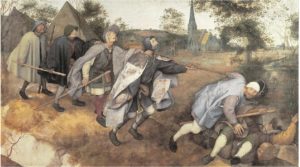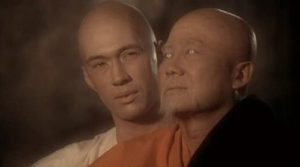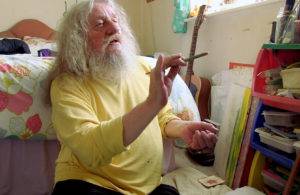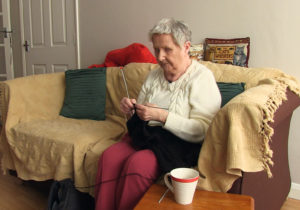The Concept (Director’s Statement)
After having made a short documentary, A Touch of Colour, about blind painter Terry Hopwood-Jackson in 2004, I started exploring how stereotypical representations of blindness operate in media. Since I am neither blind, nor do I have any blind relatives or acquaintances, this exploration emerged out of my interest to make films about people from marginalised, stigmatised or misrepresented communities.
Whether in art, literature or media, blind people have been consistently represented as either unfortunate, disabled and deprived (figure 1), or as exotic, mysterious and in touch with the supernatural (figure 2). This depiction of the blind person as the “abnormal other” is the symptom and, at the same time, partial cause for prejudicial attitudes and practices held by non-blind, and especially non-disabled, people.
| Figure 1 | Figure 2 |
 |
 |
| The Blind Leading the Blind (1568, Pieter Brueghel the Elder) | Master Po in Kung Fu (1972-1975) |
As a filmmaker and media scholar, I wanted to find ways to reduce these ‘othering’ stereotypes through adopting a kind of ‘critical film practice’, which uses insights from film studies, disability studies, social-cognitive psychology and anthropology to better understand the possible social impact of narrative and aesthetic representation in my films. The results were two feature documentaries about two non-congenitally and totally blind people: The Terry Fragments and June’s Patchwork. Unlike my previous film, A Touch of Colour, The Terry Fragments depicts not only Terry’s painting process but many other aspects of his daily life, such as solving crossword puzzles with his dedicated partner Pam and writing short stories. June’s Patchwork features June Bretherton, a former drama teacher who is now a freelance writer and consultant on issues affecting blind people, enjoying long walks with her dedicated partner David to the beach or the local pier.
 |
 |
| Terry Hopwood-Jackson | June Bretherton |
Both films aim to represent Terry and June from their own everyday perspective, rather than imposing formulaic, emotion-laden plots onto their lives. The purpose is to show them as complex and multi-layered screen personas, rather than stereotypical characters that function mainly through their blindness. As the narrative does not revolve only around their disability, their visual impairment is neither foregrounded, nor pushed into the background. It is merely one, amongst many others, embodied feature of their ordinary everyday lives.
I used several strategies to pursue the representation of multi-layered characters and ordinary lives (‘ordinary’ from Terry’s and June’s own perspective). The main one was narrative fragmentation, a technique that was successfully used in Thirty Two Short Films About Glenn Gould (1993, François Girard), a complex character portrait about an idiosyncratic person. So, both my films consist of assembled episodes that significantly differ in terms of mood, cinematic style, audience address and the filmmaker’s intervention. These episodes include observations of everyday routines, interviews, poetic montage sequences, volatile interactions between character and filmmaker, and characters reflecting about beloved objects to the camera.
The question remains why I have not put Terry and June into one film. After all, they are markedly different in their living conditions, their activities, their temperament and their feelings about being blind. This would have created an interesting and dynamic juxtaposition of two blind characters. At the same time, that juxtaposition would have highlighted their similarity of being blind, shifting the film’s focus on their disability. Also, comparing them would have jeopardised the audience’s experience of Terry’s and June’s individuality, creating simplified binary opposites (which is the same way stereotypes operate in general).
All in all, it is my hope that the viewer will perceive Terry and June as ordinary characters, who do ordinary things, albeit with an extraordinary body.
Catalin Brylla, 2018
My written work on disability representation:
A Social Cognition Approach to Stereotyping in Documentary (2018)
The Everydayness of Painting: Undoing Stereotypes of Blindness (2018)
Documentary and Disability (2017)
Spectatorship and Alternative Portrayals of Blindness (2017)
Representation of blind people in art, media and literature:
Seeing with the Hands: Blindness, Vision and Touch After Descartes (2016, Mark Paterson)
Othering Blindness – On Modern Epistemological Politics (Michael Schillmeier, 2006)
Blindness: The History of a Mental Image in Western Thought (2001, Moshe Barasch)
Representation of disability in media:
https://mediadisability.wordpress.com/
The Art of Disability: A handbook about Disability Representation in Media (2016, David Proud)
Disability and the Media (2015, Katie Ellis (Author), Gerard Goggin)
Different Bodies: Essays on Disability in Film and Television (2013, edited by Marja Evelyn Mogk)
Representing Disability in an Ableist World: Essays on Mass Media (2010, Beth Haller)
The Problem Body: Projecting Disability on Film (2010, edited by Sally Chivers and Nicole Markotic)
Disability and the Media: Prescriptions for Change (2005, Charles A. Riley)
The Cinema of Isolation: A History of Physical Disability in the Movies (2994, Martin F. Norden)
